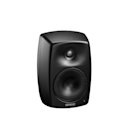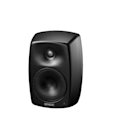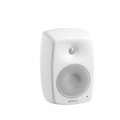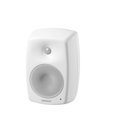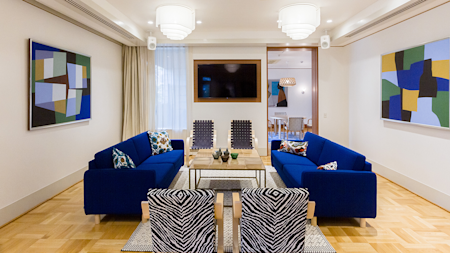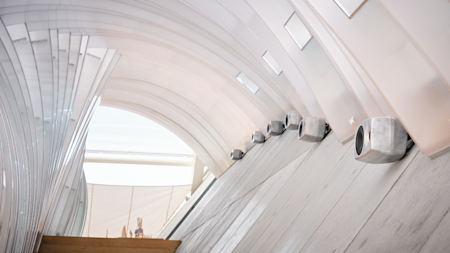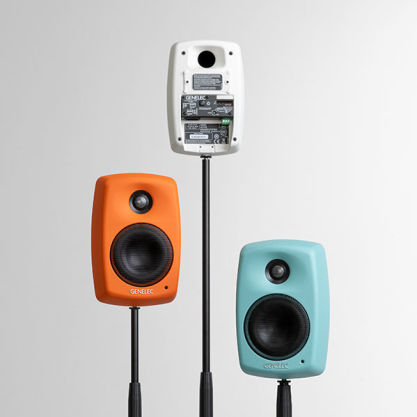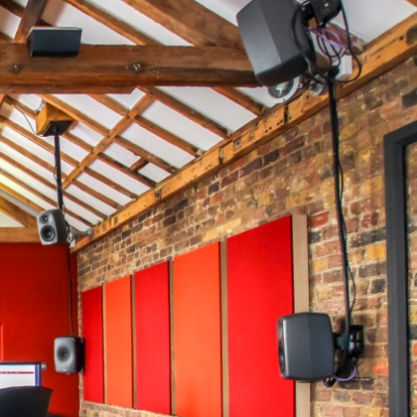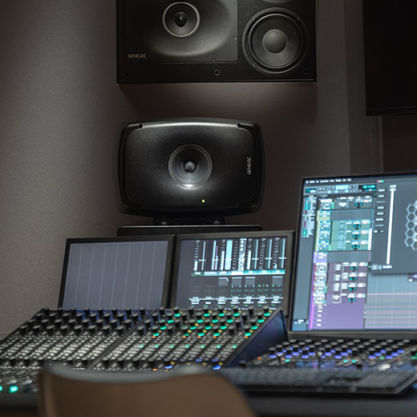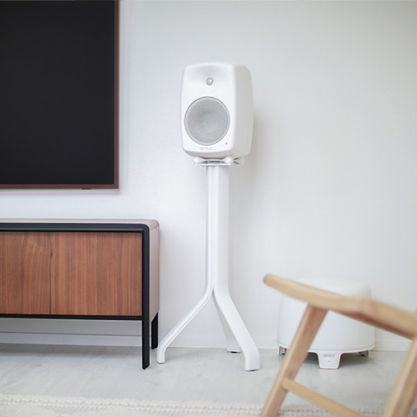¿Busca un sonido excepcional a través de IP? El 4430A ofrece administración de energía, audio y gestión de altavoces a través de un único cable CAT estándar, brindando flexibilidad, rentabilidad y simplicidad de instalación incomparables.
4430A
Altavoz para Instalación IP Inteligente

SPL
104 dB

Potencia del amplificador
50 W Bass (Class D) + 50 W Treble (Class D)

Respuesta en frecuencia
45 Hz - 39 kHz (-6 dB)

Precisión de la respuesta en frecuencia
± 1.5 dB (58 Hz - 20 kHz)

Dimensiones del altavoz
⌀ 130 mm Woofer + ⌀ 19 mm Tweeter (ver en pulgadas)

Dimensiones
H 285 x W 189 x D 178 mm, (ver en pulgadas)

Peso
5.1 kg / 11.2 lb

Conexiones
1 x RJ45 AES67 / Dante Input
1 x Euroblock Analog Input
4430A Smart IP Installation Speaker
Especificaciones técnicas
¿Busca un sonido excepcional a través de IP? El 4430A ofrece administración de energía, audio y gestión de altavoces a través de un único cable CAT estándar, brindando flexibilidad, rentabilidad y simplicidad de instalación incomparables.

Especificaciones del sistema
Respuesta en frecuencia
58 Hz - 20 kHz (± 1.5 dB)
Corte de graves -6 dB
45 Hz
Corte de agudos -6 dB
39 kHz
SPL
SPL pico Máximo pico de salida acústica por unidad en sala de escucha con material musical a 1 metro usando alimentación PoE+.
≥107 dB
SPL máximo a corto plazo Máxima salida acústica instantánea de onda sinusoidal sobre el eje de referencia en espacio medio, promedio 100Hz - 3KHz a 1 metro usando alimentación PoE+.
≥104 dB
Máximo SPL a largo plazo Máxima salida acústica constante en condiciones equitativas con IEC ruido mesurado a 1 metro usando alimentación Poe+ (Limitado por el circuito de protección del transductor y la fuente de alimentación PoE.
≥96 dB
Ruido propio
Ruido propio Nivel de Ruido Inherente en espacio abierto a 1 metro sobre el eje de referencia (A-weighted).
≤5 dB
Peso
Peso5.1 kg (11.2 lb)
Dimensiones
Altura
285 mm
Anchura
189 mm
Profundidad
178 mm
Dimensiones Alto 285 mm Ancho 189 mm Profunda 178 mm
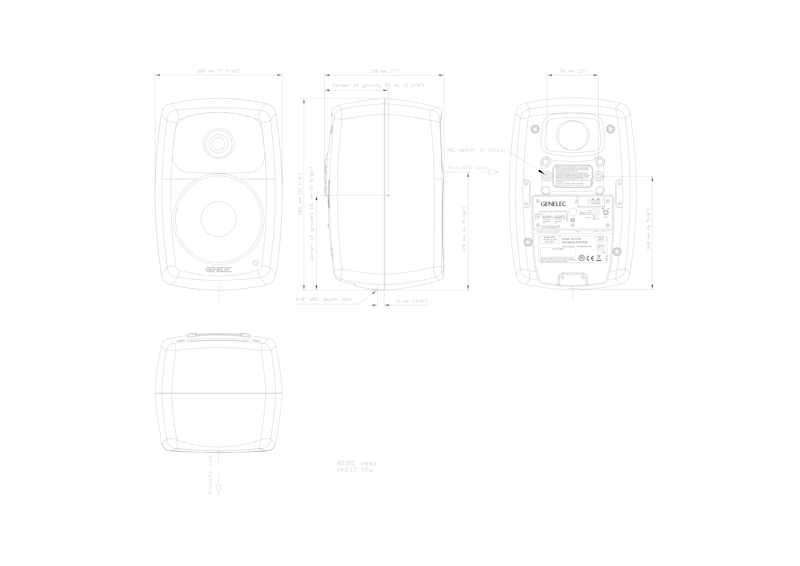
Recinto
Material del recinto
Die cast aluminium
Tipo de recinto
Reflex port
Altavoces
Tipo de altavoz
Cone
Diámetro
130 mm
Tipo de altavoz
Metal dome
Diámetro
19 mm
Directividad
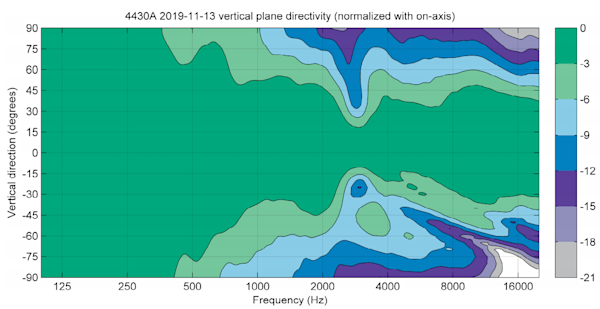
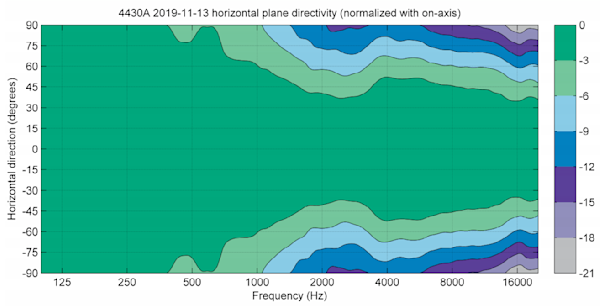
Distorsión armónica
200 Hz ≤0.5 %
Retardo de grupo
La latencia en altas frecuencias desde la entrada hasta la salida acústica, medida en la entrada análoga.
2.3 ms
En los gráficos de rendimiento de Genelec, el tiempo de conversión de una señal de entrada electrónica a una salida acústica en un monitor Genelec se describe mediante dos factores: latencia y retardo de grupo. El factor de retardo de grupo se puede leer en los gráficos para una frecuencia específica. El retardo total de entrada a salida específico de la frecuencia es una suma de los factores de latencia y retardo de grupo. Para comprender el significado de este retraso total, considere que alejar un altavoz 1 metro crea un retraso adicional de aproximadamente 3 ms.
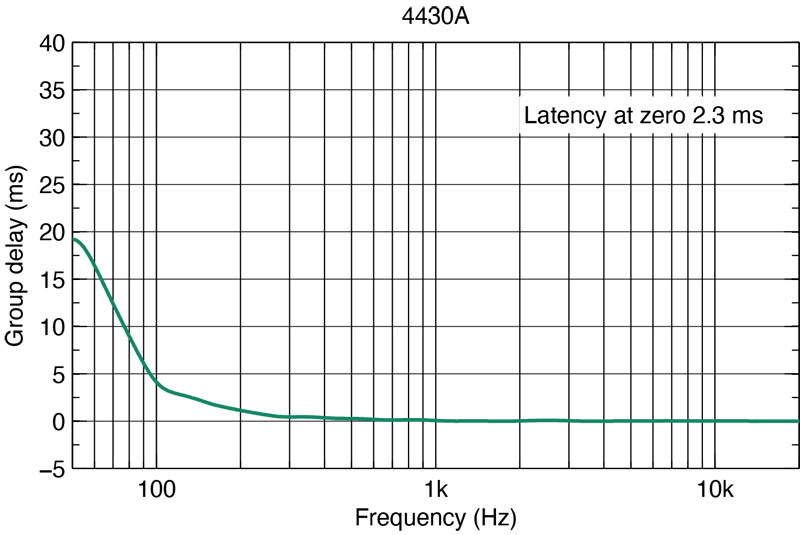
Sección de amplificación
Amplificadores
50 W Class D
50 W Class D
Voltaje de la toma eléctrica
PoE+/PoE
Consumo de potencia
Con ISS activo
≤4 W
En reposo
≤5 W
A pleno rendimiento
25.5 W
Sección de procesado de señal
Conectores
Input Ethernet (Power over Ethernet and Audio over IP)
Input Audio input is via a 10 kOhm balanced connector.
Filtro de cruce
Bass/Treble
2900 Hz
Variantes de producto
Códigos de producto
Para más detalles técnicos consulte por favor el manual de operación del producto

Poder Real para el Altavoz
Combinando una calidad de sonido líder en su clase con la comodidad de un solo cable, el 4430 utiliza PoE para producir SPL y rendimiento acústico sin concesiones, y es totalmente compatible con Dante y estándares de transmisión abierta como AES67. Fabricado en Finlandia utilizando métodos sostenibles certificados, el 4430 brindará décadas de un servicio confiable.

Poder para el Instalador
Como parte de la familia IP Inteligente, el 4430 se integra estrechamente con nuestro software Smart IP Manager, que permite a los instaladores configurar una cantidad casi ilimitada de salas, zonas, altavoces y canales de audio, e incluye la funcion de reconocimiento de dispositivos, un conjunto versátil de herramientas de ecualización de sala, organización del sistema y seguimiento del estado del sistema. Después de lo cual, un conjunto de comandos API público que permite integrar el 4430 en sistemas de automatización del hogar para un uso diario. Fácil.

¿Dónde comprar?
1 altavoz de instalación IP inteligente 4430A.
1 x soporte simple
1 x juego de tornillos de montaje
1 bloque de terminales de 3 posiciones
4430A
Awards
Available in 120 RAL colours
Would you like to match your speakers with your interior design?
No problem – simply choose from our wide range of colour options.
Documentación
Documentos
4430A Operating Manual 4430A Quick Setup Guide Genelec Smart IP Brochure Special Colour Options Smart IP FAQ Case Study G Livelab Tampere Smart IP Manager - Operating ManualDescargas
4430A Line Drawings (pdf) 4430A Line Drawings (dwg) 4430A - Simulation File (GLL) 4430A - Simulation File (EASE 4) 4430A - Simulation File (CLF) NOTE: Simulation File Use for 4430APreguntas frecuentes
Genelec Smart IP is a revolutionary family of loudspeakers for installed audio applications, supporting single-cable connectivity via standard Ethernet networking protocols. Smart IP loudspeakers receive power and audio, plus monitoring and management signalling over a single Ethernet cable. Smart IP does not introduce any performance compromises in terms of maximum sound pressure level or acoustic quality. It provides complete professional-quality room compensation and multi-loudspeaker system alignment tools built into all loudspeakers and allows several complete setups to be stored within the loudspeaker’s internal memory. Smart IP also enables easy integration into house automation systems by offering a public API command set – and the Smart IP Controller app for small installations.
• Single-cable connectivity using PoE+ and PoE without performance sacrifice.
• High maximum SPL on PoE+ power.
• Renowned Genelec audio and build quality.
• Support for open audio and IP standards, and compatible with both Dante and AES67 streams.
• Uncompromising uncompressed low-latency audio streaming directly into each loudspeaker.
• Loudspeaker synchronisation to sub-microsecond level for solid acoustic imaging.
• Full set of acoustic room compensation and alignment tools built into each loudspeaker.
• Extensive accessory support.
• Complete public API command set, for easy integration with third-party automation systems.
• Access to Genelec’s Smart IP Manager configuration software offering device discovery, room equalisation, zone organisation and status monitoring.
• Designed and manufactured in Finland for high reliability and a long lifetime, with careful consideration of environmental sustainability.
Almost any project, since the number of Smart IP loudspeakers in one installation is virtually unlimited and IP networks support a very high loudspeaker count. This, together with the highly flexible audio streaming options supported by Smart IP, enables complex installations with many loudspeakers to be implemented quickly and easily.
Tecnologías clave
Audio-over-IP (AoIP)
PoE Power
Smart IP Manager

Active Crossovers

Directivity Control Waveguide (DCW™) Technology

Intelligent Signal Sensing (ISS™) Technology

Minimum Diffraction Enclosure (MDE™) Technology

Optimised Amplifiers

Protection Circuitry

Reflex Port Design

Versatile Mountings
Audio-over-IP (AoIP)
The advancing adoption of networked audio has been huge, so we've responded by developing both AV loudspeaker and studio solutions that support AoIP streams, with all the precision and clarity that audio professionals have come to rely on from Genelec.
For demanding AV applications, our growing family of Smart IP loudspeaker models support Ravenna and Dante-compatible AES67 streams. Smart IP employs uncompressed low-latency audio streaming directly into each loudspeaker, with loudspeaker synchronisation to sub-microsecond level for solid acoustic imaging.
For audio professionals using AoIP connectivity, the Genelec 9401A System Management Device enables the smooth integration of Smart Active (SAM) Monitors and Subwoofers into SAM system layouts, from stereo to immersive, using ST2110, AES67 and Ravenna streams as the source – while offering full support for room adaption from our powerful Genelec Loudspeaker Manager (GLM) software.
PoE Power
Power-over-Ethernet allows our Smart IP loudspeakers to deliver impressive performance over a single CAT cable.
Our Smart IP loudspeakers support the widely used PoE+ and PoE technology standards. IEEE 802.3at (30 W) is recommended, with IEEE 802.3af (15 W) simply reducing the time that maximum power output can be maintained.
Smart IP loudspeakers utilise proprietary internal power management that delivers a significantly higher SPL than was previously possible via any conventional PoE. In fact, Smart IP can produce maximum SPL whenever needed, sufficient to power small and medium sized audio systems — a world first.
Smart IP’s internal power supply stores power, to enable Smart IP loudspeakers to work with real audio signals, music, and speech. Since audio signals are dynamic, periods of high peak power typically have finite duration while the effective average power level, or RMS power, remains much lower.
By employing PoE over a single standard CAT cable, Smart IP loudspeakers offer low power consumption and reduced cabling requirements, for a sustainable and affordable loudspeaker solution.
Smart IP Manager
Powerful software that provides total control of Smart IP networked loudspeaker systems.
To address the specific needs of installers, Smart IP Manager offers an array of software tools focused on solving specific installation audio problems – including device discovery, room equalisation, system organisation and status monitoring. This saves installers a substantial amount of working time and ensures that Smart IP loudspeaker systems always perform with outstanding clarity and speech intelligibility – even in acoustically challenging environments.
Smart IP Manager software is specifically designed to be used by installers during the system set-up, and allows the configuration of almost unlimited numbers of rooms, zones, loudspeakers and audio channels. After which, a public API command set allows Smart IP speakers to then be integrated into house automation systems ¬– enabling end user control of simple parameters including volume, power on/off, loudspeaker activity and a section of pre-programmed settings.
To help cope with challenging acoustic environments, Smart IP Manager integrates with the loudspeaker’s internal DSP to enable the analysis and corrective equalisation of any detrimental room acoustics, along with control of delay and level alignment. Internal memory within the speaker then provides instant recall of settings, allowing fast and accurate deployment in any environment.
Active crossover operating at low signal levels.

Audio electronic crossovers allow the audio signal to be split into separate frequency bands that are separately routed to individual power amplifiers, which are then connected to specific transducers optimised for a particular frequency band.
Active crossovers come in both digital and analogue varieties. Genelec digital active crossovers include additional signal processing, such as driver protection, delay, and equalisation.
Genelec analogue active crossover filters contain electronic components that are operated at low signal levels suitable for power amplifier inputs. This is in contrast to passive crossovers that operate at the high signal levels of the power amplifier's outputs, having to handle high currents and, in some cases, high voltages.
In a typical two-way system the active crossover needs two power amplifiers — one for the woofer and one for the tweeter.
The active crossover design offers multiple benefits:
- The frequency response becomes independent of any dynamic changes in the driver's electrical characteristics or the drive level.
- There is increased flexibility and precision for adjusting and fine-tuning each output frequency response for the specific drivers used.
- Each driver has its own signal processing and power amplifier. This isolates each driver from the drive signals handled by the other drivers, reducing inter-modulation distortion and overdriving problems.
- The ability to compensate for sensitivity variations between drivers.
- The possibility to compensate for frequency and phase response anomalies associated with a driver’s characteristics within the intended pass-band.
- The flat frequency response of a high-quality active loudspeaker is a result of the combined effect of the crossover filter response, power amplifier responses and driver responses in a loudspeaker enclosure.
Using the active approach enables frequency response adjustments and optimisation of the full loudspeaker system, placed in various room environments, without expensive external equalisers. The end result is a simpler, more reliable, efficient, consistent and precise active loudspeaker system.
Directivity Control Waveguide (DCW™) for flat on and off-axis response.

A revolutionary approach was taken by Genelec in 1983 with the development of its Directivity Control Waveguide (DCW™). We have developed and refined this technology over more than 30 years to greatly improve the performance of direct radiating multi-way monitors.
The DCW technology shapes the emitted wavefront in a controlled way, allowing predictable tailoring of the directivity (dispersion) pattern. To make the directivity uniform and smooth, the goal is to limit the radiation angle so that the stray radiation is reduced. It results in excellent flatness of the overall frequency response as well as uniform power response. This minimises early reflections and provides a wide and controlled listening area achieving accurate sound reproduction on and off-axis.
Minimised early reflections and controlled, constant directivity have another important advantage: the frequency balance of the room reverberation field is essentially the same as the direct field from the monitors. As a consequence, the monitoring system's performance is less dependent on room acoustic characteristics.
Sound image width and depth, critical components in any listening environment, are important not only for on-axis listening, but also off-axis. This accommodates not only the engineer doing their job, but also others in the listening field, as is so often the case in large control rooms.
DCW™ Technology key benefits:
- Flat on and off-axis response for wider usable listening area.
- Increased direct-to-reflected sound ratio for reduced control room coloration.
- Improved stereo and sound stage imaging.
- Increased drive unit sensitivity up to 6 dB.
- Increased system maximum sound pressure level capacity.
- Decreased drive unit distortion.
- Reduced cabinet edge diffraction.
- Reduced complete system distortion.
Intelligent Signal Sensing (ISS™) for power consumption reduction in stand-by mode.

Introduced early 2013, Genelec’s Intelligent Signal-Sensing technology has been developed to meet with both European Union ErP Directives and Genelec's own ambitious sustainability standards.
The Intelligent Signal Sensing, ISS™ circuitry tracks the signal input of the loudspeaker and detects if it is in use. If the ISS circuit does not find any audio on the input for a period of time, it sets the loudspeaker to a low-power sleep state and the loudspeaker will consume less than 0.5 watts. When an input signal is detected, the loudspeaker immediately turns itself on.
Additionally an ‘ISS Disable’ switch is located on each product’s back plate next to the other room response controls. First, when the mains power switch of the loudspeaker is set to 'ON', the ISS™ auto-start function (low-power sleep state on/off) of the loudspeaker is active.

If this function is not desired, the ISS™ function can be disabled by setting the 'ISS Disable' switch on the back panel to 'ON' position. In this mode, the monitor is only powered on and off using the mains power switch.
Note that the mains power switch will always turn the monitor off completely.
Minimum Diffraction Enclosure (MDE™) for uncoloured sound reproduction.

A common problem with standard free-standing loudspeakers is that the front baffle discontinuities cause diffractions and the loudspeaker sharp corners act as secondary sources through reflections.
In order to improve the flatness of the frequency response and the power response of free standing loudspeaker systems, Genelec have designed a highly innovative enclosure optimized to match the properties of the monitor drivers, featuring rounded edges, and gently curved front and sides. In addition to achieving an unsurpassed flatness of the frequency response, the enclosure having minimum diffractions yields superb sound stage imaging qualities.
To achieve such a smooth and elegantly curved cabinet surface and to reduce the outer dimensions of the enclosure, maximising at the same time the internal volume for improved low frequency efficiency, we designed a cabinet made off die-cast aluminium. Aluminium is lightweight, stiff and very easy to damp to yield a “dead” structure. The cabinet walls can be made fairly thin, providing at the same time good EMC shielding and excellent heat sink for the power amplifiers. Die-casting is made in two parts, front and rear, and they are easy to separate for potential servicing needs.
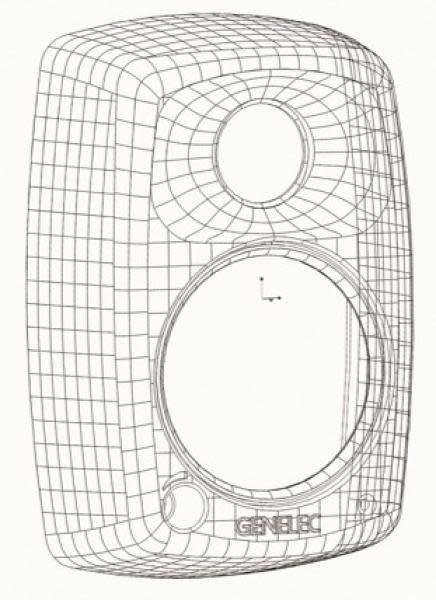
The DCW waveguide has been integrated in the MDE aluminium enclosure to provide improved control of the loudspeaker’s directivity. Basically, the low frequency limit for constant directivity is determined by the size of the waveguide, so the larger the surface the better the control. With a very controlled off-axis radiation, the listening window becomes consistent, which is of utmost importance with multi-channel audio monitoring. Controlled directivity also reduces possible first order reflections on surfaces near the loudspeaker, helping to provide consistent audio reproduction in different acoustical environments. In fact, the entire front baffle is gently curved and the acoustically transparent grilles are part of the outer cabinet aesthetics, blending perfectly with the various other curved surfaces.

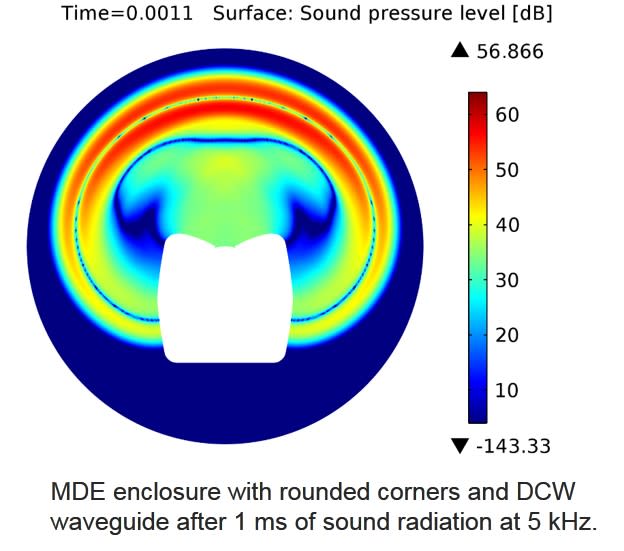
Each transducer is driven by its own optimised amplifier.

Audio electronic crossovers allow to split the audio signal into separate frequency bands that can be separately routed to individual power amplifiers, which are then connected to specific transducers optimised for a particular frequency band.
In a typical 2-way loudspeaker system, the active crossover needs two power amplifiers — one for the woofer and one for the tweeter. The power amplifiers are connected directly to the drivers of an active loudspeaker, resulting in the power amplifier’s load becoming much simpler and well known. Each driver-specific power amplifier has only a limited frequency range to amplify (the power amplifier is placed after the active crossover) and this adds to the ease of design.
The active design principle offers multiple benefits:
- The power amplifiers are directly connected to the speaker drivers, maximising the control exerted by the power amplifier’s damping on the driver’s voice coil, reducing the consequences of dynamic changes in the driver electrical characteristics. This may improve the transient response of the system.
- There is a reduction in the power amplifier output requirement. With no energy lost in the passive crossover filter components, the amplifier power output requirements are reduced considerably (by up to 1/2 in some cases) without any reduction in the acoustic power output of the loudspeaker system. This can reduce costs and increase audio quality and system reliability.
- No loss between amplifier and driver units results in maximum acoustic efficiency.
- Active technology can achieve superior sound output vs. size vs. low frequency cut-off performance.
- All loudspeakers are delivered as a factory aligned system (amplifiers, crossover electronics and enclosure-driver systems).
Sophisticated drive unit protection circuitry for safe operation.

When working in critical audio production environments it is essential that monitoring systems remain reliable and functional at all times. One of the main reasons behind Genelec’s excellent success in broadcasting environments is the reliability of our products and a key element behind the reliability is the internal protection circuitry found in all products since 1978.
The protection circuitry prevents driver failures by detecting signal levels, and in case of sudden peaks or constantly too high levels, taking the signal level down automatically. Of course this feature does not affect the sound quality in any way when working within the specifications of the loudspeaker, but only prevents inadequate input signals from breaking the loudspeaker.

Protection circuitry features and benefits:
- Reduces the output level when required, (e.g. when driver voice coil temperature reaches the safe limit), which highly improves system reliability.
- Appropriate protection circuitry design in every loudspeaker and subwoofer enables the maximisation of system output sound level.
Advanced reflex port design for extended low frequency response.

Genelec’s choice for vented, or reflex, enclosures dates back to the S30 model, the first Genelec product from 1978. Port performance has been improved and refined over the years with the aim to increase the woofer’s low frequency extension and sound pressure level capability to provide outstanding bass articulation and definition.
Both driver and vent contribute to the total radiation of a reflex enclosure. Most radiation comes from the driver, but at the vent-enclosure resonant frequency the driver displacement amplitude is small and most of the radiation comes out of the vent.
To minimise the air speed in the tube, the cross sectional area of the vent should be large. This in turn means that the vent tube has to be long which presents quite a design challenge.
The long, curved tube maximises airflow so deep bass can be reproduced without compression. The reflex tube terminates with a wide flare located on the rear of the enclosure, minimising port noises and providing excellent bass articulation.
The curvature of the tube has also been carefully designed to minimise any audible noise, compression or distortion. The inner end of the tube has proper resistive termination to minimise once again audible chuffing noise and air turbulence.
Proper reflex port design allows also to significantly reduce the woofer’s displacement, improving the linear low frequency output capacity.
Versatile mounting options for all installation needs.

In addition to perfect acoustical design and advanced tailoring options to optimize the loudspeaker’s behaviour to the room environment, Genelec loudspeakers offer a variety of mounting options for easy installation in different applications.
Our wide range of accessories and fixed mounting points on the back of our aluminium enclosure products offer solutions to all common installation situations. M6 support points have been integrated in the die-cast enclosure for wall and ceiling mounts.
Some models also feature a 3/8” thread at the bottom of the enclosure to fit a robust microphone stand. Other larger and heavier models feature M10 fixing points. Special floor stand plates have been designed in order to fit the Iso-Pod stand that is part of our product design.
With these features our loudspeakers have found their way to a variety of applications beyond the professional audio and studio world, for example in commercial and AV installation projects as well as in home environments all around the world.
Referencias
Genelec Smart IP | Premium networked audio for AV made simple
Genelec Smart IP | Quick Setup Guide - How to create a simple networked audio system
Genelec Smart IP | Supercell AV: Premium audio adds muscle to mobile-gaming giant’s HQ
Genelec Smart IP helps deliver multisensory experience at Finnish Music Hall of Fame
Genelec and G Livelab Tampere: creating the perfect live music venue | Genelec AV
Genelec Smart IP Controller | Mobile and tablet app for Android and iOS
Genelec Smart IP | Premium networked audio for AV made simple
Introducing Smart IP. Genelec's family of elegant loudspeakers for premium audio over a single CAT cable.
Genelec Smart IP | Quick Setup Guide - How to create a simple networked audio system
In this video, Genelec expert, Marcel Schechter, walks you through the basic steps of creating a Smart IP installation: Connecting the loudspeakers to the network switch with a CAT cable, connecting your computer to the network switch, downloading our free software and using Dante Controller/Virtual Soundcard.
Genelec Smart IP helps deliver multisensory experience at Finnish Music Hall of Fame
“Genelec's new Smart IP technology was a perfect choice for us, offering a complete solution with the highest quality and flexibility which means savings in working time, maintenance and investment costs. We achieved everything we wanted and more, and the immersive sound world and listening environment in certain areas of the Fame Music Museum - as well as the neutral, transparent sound throughout - is something to be experienced. Customer feedback has been nothing but positive.”: Olli Ilmolahti, Hall of Fame board member.
Genelec and G Livelab Tampere: creating the perfect live music venue | Genelec AV
We go behind the scenes with the team from G Livelab in Tampere, Finland to find out how they’ve designed and created a live music venue that is regarded as ‘sonically and acoustically speaking, perfect.’ Deploying a network of over eighty Genelec loudspeakers - including forty four 4430 Smart IP installation speakers - they are now able to host live performances that will ‘most likely sound better than the record.’ Watch the video to find out exactly how they did it.
Encuentra tu representante









